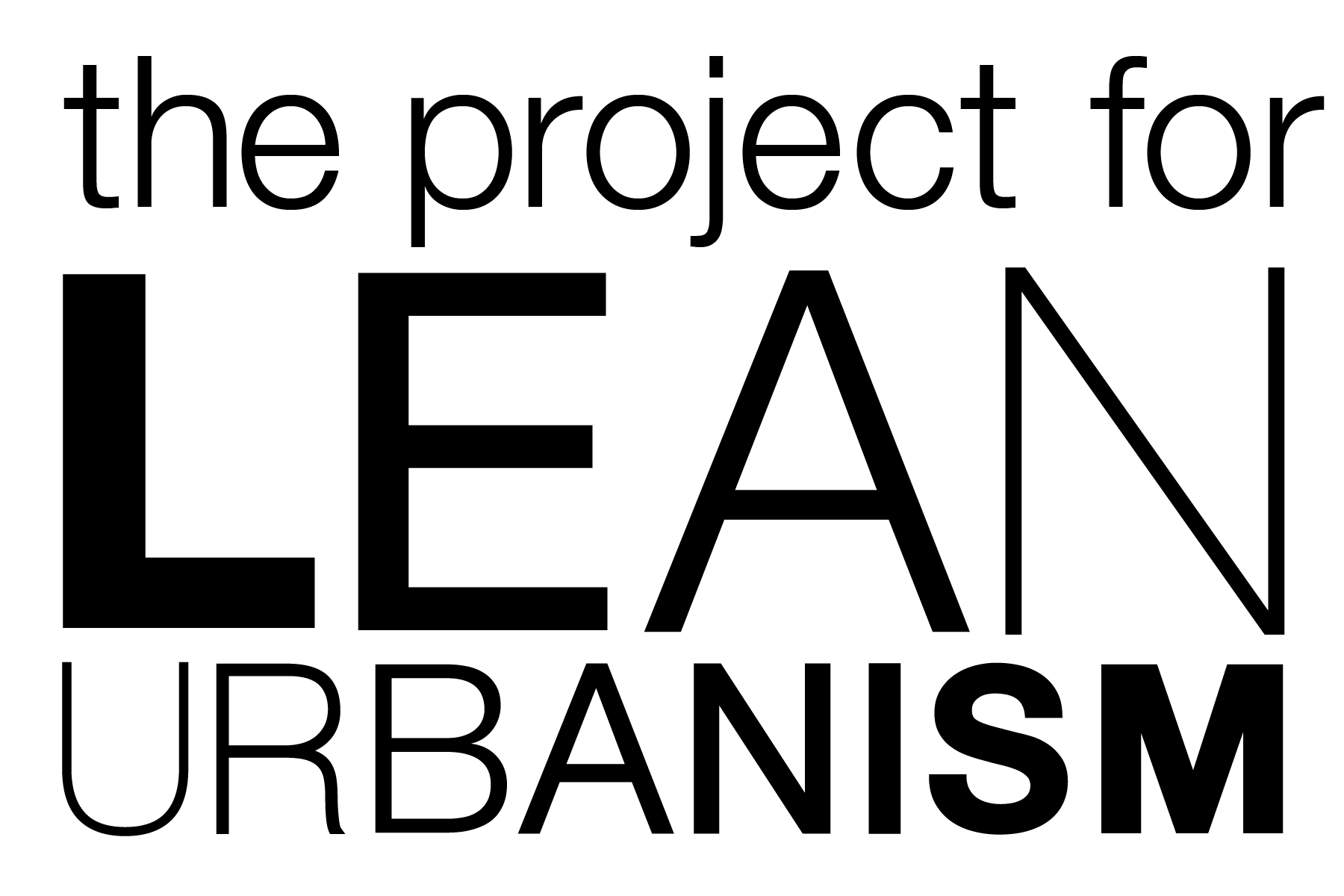Background
Lean Urbanism is an approach to community-building that requires fewer resources. It is a response to the requirements, complexities and costs that disproportionately burden small-scale developers, builders, and entrepreneurs. The Project for Lean Urbanism is developing tools and daylighting techniques to better enable small-scale development and entrepreneurial activity by focusing on incremental, successional growth, by reducing the resources required for compliance, and by providing ways to work around onerous financial, bureaucratic, and regulatory processes. The tools and techniques will be released freely, for all to use. These tools, along with the focus on requiring fewer resources and working around onerous processes, will allow more people to participate in building their homes, businesses, and communities.
What Is a Pink Zone?
A Pink Zone — an area where the red tape is lightened — is the locus for implementation of Lean strategies and improvements, and it identifies an area where new protocols are pre-negotiated and experiments are conducted, all with the goal of removing impediments to economic development and community-building.
A Pink Zone has some similarities to an innovation district, another recent planning initiative. Innovation districts are also used to spur revitalization, engage populations that have been left out of the development process, stimulate sustainable economic activity and asset-building through incubator and maker spaces, and address both physical assets and community assets. The two techniques are different in that innovation districts tend to focus exclusively on jobs, while Pink Zones also address housing, and innovation districts primarily encourage new technologies, commercial innovation and high-growth businesses, while Pink Zones encourage community-supportive enterprises such as Main Street businesses and start-up makers and platforms such as shared work spaces, kitchens, community hubs, and markets.
A Pink Zone is not created in isolation. It follows an assessment of the impediments and assets in a community, and is implemented with a carefully chosen kit of tools. This process is being tested and refined in a series of pilot projects, after which the Pink Zone will be among the tools freely released by the Project for Lean Urbanism.
The purpose of the pilot projects is to identify viable, short-term, incremental improvements and the talent and resources needed to make them, to identify blockages and barriers, and to develop mechanisms for getting past them. Each pilot project will consist of three phases: an assessment, a workshop, and implementation. The three primary products of a pilot project are the Lean Scan, used in the assessment phase, a Pink Zone, created in the workshop phase, and an action plan to be used in the implementation phase.
Assessment Phase and Lean Scan
The Lean Scan is a tool for finding latent opportunities and leveraging under-used assets in a way that unlocks synergies between built, financial, social and natural resources. It can be commissioned by or for a municipality or a community.
The Lean Scan shifts the focus from the master plan and the large-scale project to local initiative and achievable results, narrowing the field of investigation to short-term projects. The results will be used to guide the workshop to create the Pink Zone.
Unlike a typical charrette or public-engagement process, the Lean Scan is a purposeful exercise in identifying barriers and finding opportunities for economic development. It is not only about engaging and decoding the power structure. Rather, an important function is to find and unlock hidden assets, including people and organizations, so the outreach function is targeted to finding those who have the will, talent, and energy to make good things happen. The focus will be on the people who want to develop properties and open businesses, and the community lenders and investors who finance them. The Lean Scan will also identify those who will participate in the Pink Zone workshop, and the likely members of the implementation team that will take the initiative forward.
Another important task of the Lean Scan is to identify a defined geographic area for the Pink Zone. The criteria for a Pink Zone include:
- The area is roughly the scale of a neighborhood, district, or corridor.
- It is located on a movement corridor and accessible by street and public transit.
- It includes residential and commercial components.
- The area is neither completely failing nor overheated, and developer interest has not yet started the process of land assembly and the flipping of properties.
- Land and housing are relatively affordable.
- The area has seen some development activity, but is held back by challenges that can be addressed by engaging local government, civic institutions, and small businesses and small developers in a collaborative effort at small-scale, organic improvement.
- Leadership supports the need for reducing process burdens for small enterprise, development, self-building, and retrofit.
- Local businesspeople, homeowners and residents, and organizations form an engaged base of support.
- The community recognizes that empty buildings, older neighborhoods, and declining strip malls and shopping centers can be made into assets rather than liabilities if creativity and incrementalism are applied.
- The community sees diversity as an asset and is willing to tap into the energy of immigrants, millennials, makers and downshifting baby boomers.
Workshop Phase: Creating the Pink Zone and Defining an Action Plan
Next, municipal staff and elected officials will engage in a workshop with the local people and organizations identified in the Lean Scan. After confirming the boundaries of the Pink Zone, they will pre-negotiate new requirements and processes to remove the impediments to community-building and activate community assets.
Having made the area fertile for small-scale economic development, the group will create an action plan of projects, which could include the construction or renovation of housing, retail or work space, the founding of new businesses, and improvements to streets, parks, and other parts of the public realm. They could also include the creation of community assets, such as public markets or incubators, through community organizations or benefit corporations. Projects will be prioritized for one-, two-, and three-year periods, timelines will be set, and a monitoring and accountability process agreed to by the team.
Finally, the workshop participants will line up the team that will implement the action plan. This will include commitments from local government and from civic institutions such as chambers of commerce, main street organizations, and community-based nonprofits and neighborhood groups. The local government will dedicate a staff member to serve as the project facilitator, whose role will be to identify, engage and enlist key local officials who will need to be a part of the effort to lean the approval process, including planning, building, fire and other public safety officers, as well as planning commissioners and elected officials at all applicable levels of government.
Implementation Phase: Getting Projects Off the Ground
The implementation team will ensure the execution of the action plan. It will serve as a platform to pool resources, coordinate action, provide technical support, and liaise with the government facilitator.
The action plan will be up to three years in duration, but will contain projects which can be put in place as ‘easy wins’ within a twelve- to eighteen-month time frame. These might include improvements to public space, facade improvements, or traffic-calming measures. At the same time, the action plan must identify development or rehab projects and set targets for project milestones such as design, planning approval, issuance of building permits, and start and completion of construction. The action plan may also identify and set timelines for policy and regulatory actions which will need to be taken by local government, such as adoption of a Pink Zone along with a zoning overlay or a revised and coordinated approval process.It will also schedule any needed training or mentoring visits by the Project for Lean Urbanism team, and these visits will provide an occasion for interim evaluation of progress and identifying any new challenges or road blocks that may have arisen.
Tools to Be Used in a Pink Zone
The Project for Lean Urbanism is collecting and developing tools to enable and encourage small-scale development and community-building. These tools will be available for free for use in a Pink Zone to realize the projects in an action plan. Following are examples of such tools.
Lean Governing: Enabling and supporting small-scale development and enterprise
- Streamlined processes:
- Assign a member of municipal staff to be a facilitator for the Pink Zone. This person will be sure departments such as planning, building, public works, safety, and business permitting work toward the goals of the Pink Zone and can help developers and business owners satisfy requirements and find assistance. Depending on the local structure, more than one person may fill this role.
- Identify bottlenecks in approval processes to reduce the difficulty and time required.
- Lean Regulation:
- Review codes, regulations and permitting requirements to identify existing thresholds for small projects, below which review is not required or code provisions are not triggered. Make them transparent and available both to the development community and the permitters.
- Where regulations allow interpretations, establish policies that reduce burdens for small actors, small projects, and small businesses.
- Delegate authority to a lower level that is closer to the project or business. For example, a Planning Commission could delegate approval authority to the staff member assigned to oversee the Pink Zone.
- Reduced fees: Where fees for permitting, inspection, environmental impact, etc., are determined to be impediments, they should be reduced, eliminated or thresholds set which do not unfairly burden small-scale projects.
- Lean Codes:
- Adopt simplified codes that enable small-scale development and business and demystify and simplify requirements.
- Lean Reuse and Renovation: Identify and remove barriers to bringing abandoned or ill-used buildings back to productive life, avoiding the trap of spending more to meet building codes than the rehabbed value of the building.
- Cities that use the International Building Code can adopt the Existing Building Code to encourage renovation.
- Live-Work: Define provisional changes to existing codes that can facilitate the building of live-work units as a flexible, low-cost way to provide housing and work space.
- Lean Code Tool: When overhaul of a city’s zoning code is not an option, this tool can be used to identify how the code addresses issues that affect Lean Urbanism, such as maximum lot size, building height and size, fees, and parking. The tool then advises tweaks that will allow small-scale development.
- Neighborhood Code Generator: A tool being developed with a Knight Cities Challenge grant that allows neighborhood groups to create locally determined overlays that define and protect neighborhood character and provide guidance and certainty to developers.
- Paired Oversight: An experienced and senior staff member could be paired with a younger or more entrepreneurial colleague in a co-leadership role, to offer choice to applicants, encourage more nimble working by government, and create a balance between experience and energy, caution and enthusiasm.
- Mentoring: A mentor with experience in Lean Urbanism could be appointed to work with the local government facilitator.
- Pre-approved building plans for new construction and rules that allow certain building modifications and changes of use to be carried out without an application.
- Infrastructure and public realm: Identify Lean alternatives to enhance pedestrian and cycle use, calm traffic, and improve the public realm within the Pink Zone.
Lean Development: Recruiting and training small developers
- Developer in a Box: A tool to help the would-be small developer or entrepreneur get into the game by outlining the roles to be played, techniques for navigating the financial, regulatory, and bureaucratic processes, and strategies for managing the key risk stages without vast resources.
- Boot camps: Intensive sessions to provide novice developers with the tools they need to initiate small projects, including market studies, contracts, financing, construction, and property management.
- Provide developers with lists of thresholds identified above and have experienced local developers share work-arounds to local codes and processes.
- Lean building types: Analysis and roster of building types that don’t require expensive construction methods and can be built without triggering onerous code requirements such as those for elevators or additional parking; may include pre-permitting of such buildings, subject to inspection.
Lean Finance: Community banks, equity investors, local philanthropy
- Development finance: Identifying the least burdensome sources of debt and equity for the developer, from community banks and credit unions to crowd-sourcing and patient equity.
- “De-risking” investment in the Pink Zone for both community lenders and equity investors (including pools of investment capital from local professionals and businesspeople such as doctors, dentists and accountants). Examples of this “de-risking” include the training of developers and the pre-approved building plans mentioned above.
Platforms: Structures that go beyond the single project by pooling resources and supporting emerging markets within the Pink Zone. These can take many forms, including physical buildings, organizations, online portals, and open-source information.
Conclusion
Lean Urbanism is a return to the way we built cities before excessive regulations: one or two houses, retail shops and workshops at a time. It’s incremental, modest development by small-scale builders and developers that can provide affordability without subsidies. It’s economic development that focuses on the Main Street businesses that provide benefits to the local community. It’s a way for a community to revitalize itself while preserving local character and benefiting local residents. It’s happening accidentally and haphazardly in cities like Detroit. The creation of Pink Zones is a way to formalize, encourage, and support this urban version of the American Dream.


